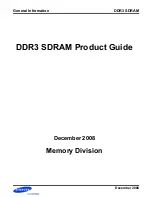
dss-083
TVDET
TVINT
TV disconnected
TV connected
TV disconnected
cvideo1_out
(vertical sync pulse)
Start of
sync pulse
Start of
sync pulse
End of
sync pulse
End of
sync pulse
Load
detection
edge of TVDET
Load
detection
Tdm
Start of
sync pulse
End of
sync pulse
Status of the load is latched
to the output on the 2nd rising
Status of the load is latched
to the output on the 1st rising
edge of TVDET
Public Version
Display Subsystem Functional Description
www.ti.com
4. Check the TVINT output signal: When TVINT is reset to 0, the load is disconnected.
5. Reset the
[0] LUMA_ENABLE bit (in s-video mode) or the
[1] COMPOSITE_ENABLE (in composite video mode) to 0 to disable the
video DAC1 output.
6. Power-down the vdda_dac voltage for the DAC stage and the TVOUT buffer (repeat every TV field
during the horizontal synchronization). This is software controlled through an I
2
C interface connected to
the power IC (TWL50xx device).
CAUTION
•
If DC coupling is selected, two TVDET pulses are required to set low the
TVINT signal. Due to the internal logic of the video DAC1, the TVINT signal
is generated after the next positive edge of the TVDET signal that happens
during the next VSYNC timing.
•
If AC coupling is selected, only one TVDET pulse is required to set low the
TVINT signal.
7.4.7.9.4 Recommended TV Detection/Disconnection Pulse Waveform
To enable the detection/disconnection of the load, the circuit requires that the TVDET pulse resembles the
following waveform. As explained in
, TV Detection Procedure, and in
TV Disconnection Procedure by using the video encoder registers, the TVDET pulse polarity, start and
stop is programmable. The only critical parameter is Tdm, which should be longer than the delay through
the AVDAC and TVOUT buffer, which is at least 750 ns.
If DC-coupling is selected, the TVINT output signal for TV detection is latched at the rising edge of the first
TVDET signal but the TVINT output signal for TV disconnection is latched after the next rising edge of the
TVDET signal that happens during the next VSYNC timing.
shows the waveforms for the
DC-coupling TV detect pulse (TVDET) when load is connected and disconnected.
Figure 7-110. DC-Coupling TV Detect Waveforms for TV Connected and Disconnected
If AC-coupling is selected, the TVINT output signal for TV detection is latched after the next rising edge of
the TVDET signal that happens during the next VSYNC timing but the TVINT output signal for TV
disconnection is latched at the rising edge of the first TVDET signal.
shows the waveforms
for the AC-coupling TV detect pulse (TVDET) when load is connected and disconnected.
1700
Display Subsystem
SWPU177N – December 2009 – Revised November 2010
Copyright © 2009–2010, Texas Instruments Incorporated
















































